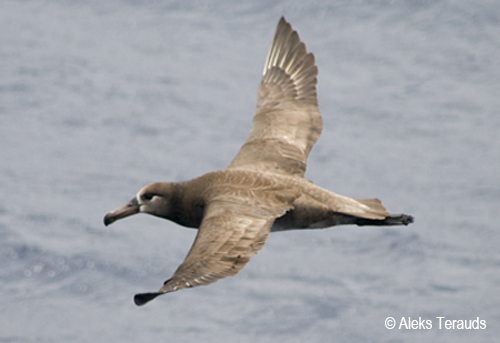Jesse Senko (School of Life Sciences, Arizona State University, USA) and colleagues, writing in the journal Animal Conservation, have looked at bycatch mitigation strategies for the Black-footed Albatross Phoebastria nigripes. They consider gear modification to be the best option to reduce mortalities.
“Marine megafauna such as seabirds, marine mammals and sea turtles are subject to high mortality from incidental capture or bycatch in fisheries. Recent research suggests that fishing effort is increasing worldwide, highlighting the need to evaluate strategies intended to reduce marine megafauna bycatch. Here, we use three focal species (i.e. leatherback turtle Dermochelys coriacea, black-footed albatross Phoebastria nigripes and vaquita porpoise Phocoena sinus) as case studies to compare management outcomes of four bycatch mitigation measures: time–area closures, individual bycatch limits, gear modifications and buy-outs. Time–area closures were used for leatherbacks and vaquitas with limited effectiveness, although timing, size and enforcement influenced their efficacy. Individual bycatch limits were employed for leatherbacks in one fishery, sometimes simultaneously with gear modifications and closures. Gear modifications consistently reduced bycatch of leatherbacks and black-footed albatross and showed strong promise for vaquitas. True buy-outs were only used for vaquitas and were costly, most fishers were unwilling to be bought out, and it is unclear if they reduced bycatch. Our review suggests that gear modifications were the most widely used and generally most promising technique for these species, although management outcomes of each strategy depended largely on the species–fishery interaction, fishery characteristics and socioeconomic context. Based on lessons learned from our case studies, we outline when and where a particular approach may be most effective, provide recommendations for improving each strategy and highlight priorities for future research.”

Black-footed Albatross at sea. Photograph by Aleks Terauds
Reference:
J. Senko, J., White, E.R., Heppell, S.S & Gerber, L.R. 2013. Comparing bycatch mitigation strategies for vulnerable marine megafauna. Animal Conservation doi:10.1111/acv.12051.
John Cooper, ACAP Information Officer, 5 June 2013

 English
English  Français
Français  Español
Español